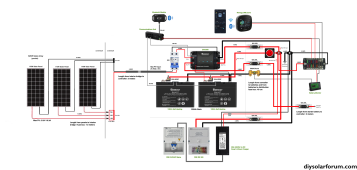herrakonna
New Member
Attachments
Last edited:
Over current fusing could be improved. Class T 100A near to the positive battery post, within 15 cm.
More ideal would be a fuse for each battery before the parallel conection. Could use MRBF fuses here with Blue Sea fuse holders.
Fuses for the feed from the DCC50, f
use for charger, fuse ( not shown ) for fuse box feed , say 40A, fuse for feed to the CBE DS300 ( not shown) say 40 A. All these need to be close to the positive junction point, ( a buss bar would be ideal) to protect the cable runs.
Fuse for the starter battery needs to be close to the battery.
Both the fuse box and the CBE DS 300 are not designed for currents over about 40 amps
Regarding the CBE system, this has chargers for the house and starter battery and a ' combiner' that connects starter and house battery, I assume you are taking steps to integrate the CBE units with the additional components.
Mike

Connecting the charge/load leads to a single battery instead of + to one battery and - to the other battery will result in battery imbalance. The battery with the connections will send/receive more current as its the path of least resistance.
View attachment 176192
If the 2 batteries have different load and charge currents they will charge and discharge differently regardless of battery type.Connecting the load to Pos/Neg posts on different batteries in the bank perhaps is only be relevant to traditional battery types and not smart LifePO4 batteries (?) as the smart batteries in the bank will all communicate with each other to balance the bank, etc.
If the 2 batteries have different load and charge currents they will charge and discharge differently regardless of battery type.
So how exactly does the balancing happen? Its either active balancing where "something" pulls from one battery and charges the other, or passive balancing where the higher battery has a load that discharges it. I see neither of these mechanisms in your diagram. Please correct me if i am wrong.
Yes but the feed cable is not rated for 100A.The fuse box is rated at 100A total,
This is a Renogy system that has been known to produce unexpected issues. You may wish not to use this feature.documentation says that the RS-485 connected batteries balance themselves and it is managed by the BMS's
will be removed from the DS 300 entirely
Yes but the feed cable is not rated for 100A.
This is a Renogy system that has been known to produce unexpected issues. You may wish not to use this feature.
You may/will loose some features, step control, fridge control
There was a report on this forum, perhaps a search will find. I seem to remember the situation, with the batteries linked, was an inability to deliver full battery current . By removing the link the batteries behaved as expected.I will look into what those issues might be. Any links?

Thanks, fortunately both of the chargers are Renogy chargers and are able to wake Renogy batteries if/as needed.There was a report on this forum, perhaps a search will find. I seem to remember the situation, with the batteries linked, was an inability to deliver full battery current . By removing the link the batteries behaved as expected.
Renogy have bizarre 'shelf' mode where the battery will shut down if no significant charge/discharge takes place, again this has been discussed on this forum.
Another issue that sometimes appears on the forum, ,(applies to many low cost batteries), is that a high charge voltage, 14.4 volts, causes the battery BMS to shutdown the charge path , ( due to cell inbalance causing the BMS to enter protection mode). This may have undesired effects on the system voltage as the charger may be slow to respond. Renogy technical help suggested lowering the charge voltage, ( down as far as 13.8 volts if necessary), not all chargers have this option. It's not usually a serious issue and over time the battery becomes more balanced.
Epever MPPT charger confused by Renogy battery inactivity?
Hi, I put a new 200Ah Renogy bluetooth battery in an existing van. The van has a Victron DC/DC charger, and an Epever MPPT solar charger. Both the Victron and the Epever MPPT have been working, and I have also seen them working on the Renogy battery. Also the Renogy battery itself works fine, it...diysolarforum.com


